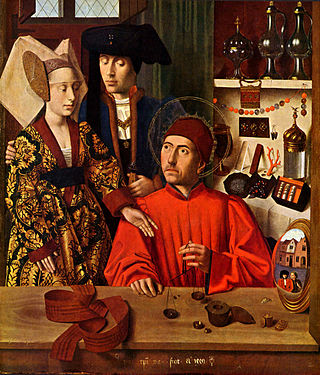
Saint Eligius was a Frankish goldsmith and bishop. He was chief counsellor to Dagobert I, the Merovingian king of France, and was appointed Bishop of Noyon–Tournai three years after the king's death in 642.
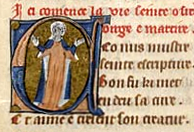
Osgyth was an English saint. She is primarily commemorated in the village of Saint Osyth, Essex, near Colchester. Alternative spellings of her name include Sythe, Othith and Ositha. Born of a noble family, she founded a priory near Chich which was later named after her.

Audoin was a Frankish bishop, courtier, hagiographer and saint.
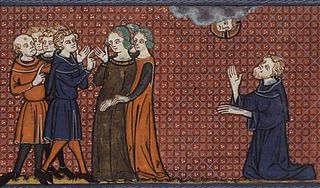
Pelagia, distinguished as Pelagia of Antioch, Pelagia the Penitent, and Pelagia the Harlot, was a Christian saint and hermit in the 4th or 5th century. Her feast day was celebrated on 8 October, originally in common with Saints Pelagia the Virgin and Pelagia of Tarsus. Pelagia died as a result of extreme asceticism, which had emaciated her to the point she could no longer be recognized. According to Orthodox tradition, she was buried in her cell. Upon the discovery that the renowned monk had been a woman, the holy fathers tried to keep it a secret, but the gossip spread and her relics drew pilgrims from as far off as Jericho and the Jordan valley.

Olivia of Palermo, Palermo, 448 – Tunis, 10 June 463, while according to another tradition she is supposed to have lived in the late 9th century AD in the Muslim Emirate of Sicily is a Christian virgin-martyr who was venerated as a local patron saint of Palermo, Sicily, since the Middle Ages, as well as in the Sicilian towns of Monte San Giuliano, Termini Imerese, Alcamo, Pettineo and Cefalù.

Saint Mildburh was the Benedictine abbess of Wenlock Priory. Her feast day is 23 February.
Saint Ava is a Roman Catholic Catholic saint, the daughter of Pepin II of Aquitaine. She was born on the 29th of April 845 AD. She was cured of blindness by Saint Rainfredis before becoming a Benedictine nun. How she became blind, whether from a birth defect or a childhood illness is unknown. Saint Ava’s feast day is the 29th of April, and she is the patron saint of the blind.

Nonnus was legendary 4th- or 5th-century Christian saint, said to have been an Egyptian monk who became a bishop in Syria and was responsible for the conversion of St Pelagia the harlot during one of the Synods of Antioch. His feast day is observed on November 10.

Godeberta was a saint and abbess. She was born of "pious parents" in Amiens, France, north of Paris. Her parents were nobles attached to the king's court, so she was carefully educated. When Godeberta was old enough, her father took her to the king's court to obtain permission to "marry her to someone of suitable rank and fortune". Saint Eligius, who was present at court, was able to see that she wanted to "dedicate her virginity to God", and took off his episcopal ring and placed it on her finger in the presence of the king, pronouncing her a nun. Godeberta refused offers of marriage by her noble suitors, and the king, impressed with her zeal and conduct, endowed Godeberta with a small palace in nearby Noyon, north of France, with a chapel dedicated to Saint George. She turned her home into a monastery, where she was abbess for 12 young women. She chose Eligius as her spiritual guide.

Saint Euphrasia was a Constantinopolitan nun who was venerated after her death as a saint for her piety and example of charity.
Rictrude was abbess of Marchiennes Abbey, in Flanders. The main early source for her life is the Vita Rictrudis, commissioned by the abbey, and written in 907 by Hucbald.

Saint Ephigenia of Ethiopia or Iphigenia of Ethiopia, also called Iphigenia of Abyssinia, is a folk saint whose life is told in the Golden Legend as a virgin converted to Christianity and then consecrated to God by St. Matthew the Apostle, who was spreading the Gospel to the region of "Ethiopia," which in this case is understood to be located in the regions south of the Caspian Sea, either in one of the provinces of Mesopotamia, or in Ancient Armenia (Colchis).

Lucy Filippini is venerated as a Catholic saint. She founded the Institute of the Maestre Pie, dedicated to the education of young girls.
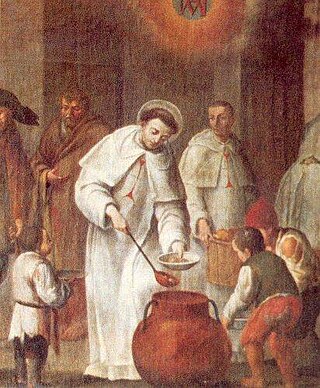
Simón de Rojas was a Spanish priest of the Trinitarian Order known as the "Apostle of the Ave Maria", for his devotion to the Blessed Virgin Mary. A person of many abilities, Rojas was a theologian and a spiritual writer, as well as a friend and benefactor of the poor.

October 22 - Eastern Orthodox liturgical calendar - October 24

Agnes of Jesus, OP was a French Catholic nun of the Dominican Order. She was prioress of her monastery at Langeac, and is today venerated in the Catholic Church, having been beatified by Pope John Paul II on November 20, 1994.
Elizabeth of Hungary, was a Hungarian princess and the last member of the House of Árpád. A Dominican nun, Elizabeth spent most of her life in Töss Monastery in today's Switzerland. Despite being the sole surviving member of the first royal house of Hungary, Elizabeth never had any influence on Hungarian politics. She became honored by the local populace as a saint.
Wendreda, also known as Wendreth, was an Anglo-Saxon nun, healer, and saint, perhaps of the 7th century. She was uncertainly reported as a daughter of King Anna of East Anglia, a Christian king, which would make her a sister of Etheldreda, abbess of Ely, Sexburgha, abbess of Minster-in-Sheppey, and Ethelburga, abbess of Faremoutiers, who are all better-known saints, and a half-sister of Sæthryth, also an abbess of Faremoutiers.
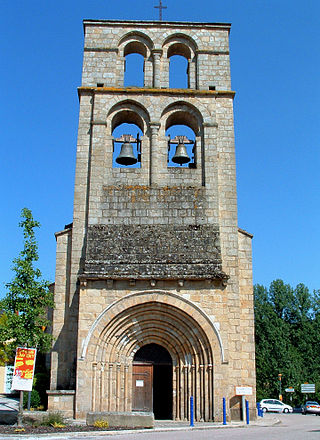
Saint Thillo was a Saxon slave who was converted by Saint Eligius and became a priest at Solignac Abbey. He accompanied Eloi in missionary work, returned to Solignac, and was made abbot. Unable to handle the responsibility, he left the abbey and became a hermit. His feast day is 7 January.

Saint Syra of Troyes was an Irish woman, sister of Saint Fiacre, who became a nun in France and died in Meaux but came to be venerated in Troyes. Her story has been conflated with that of a woman named Syria who died in Troyes in the 4th or 5th century. Her feast day is 8 June.














